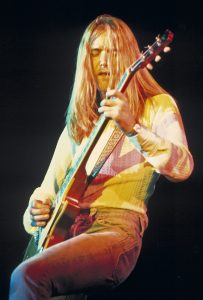interview: Kim Simmonds of Savoy Brown
Tune into WMSE as Tom Talks to Kim Simmonds of Savoy Brown on the Rock Ride in advance of the band’s show at Shank Hall in Milwaukee on November 6th – WMSE.org or 91.7 FM to listen!
Blues is not for the faint-hearted. Since the genre first drew breath, its greatest practitioners have embraced the darkness, spinning tales of hardship and death, hellhounds and devilry. If the sleeve of Witchy Feelin’ suggests that Kim Simmonds, too, has a tendency towards the macabre, then Savoy Brown’s iconic leader is happy to confirm it. “Blues has always dealt with themes of the Devil, witchcraft and so forth, and I’ve always written along those lines. At least three of the songs on Witchy Feelin’ have that hoodoo vibe…”
Released in 2017 on Ruf Records, Witchy Feelin’ proves the Devil still has all the best tunes. From the thrillingly brittle guitar riff that opens Why Did You Hoodoo Me, we are in the hands of a master, with Simmonds reigniting the seismic vocals and searing fretwork that established Savoy Brown as linchpins of the ’60s British blues boom. “On this album, I tried my best to get my voice in its power zone,” he explains. “I’m a baritone singer. I like listening to singers I can relate to, such as J.J. Cale, Mark Knopfler, Tony Joe White and Tom Rush. For my guitar playing, I still get inspiration from Otis Rush, Buddy Guy and all the Chicago players I grew up listening to back in ’63… but I always listen to new music too.”
Recording alongside Pat Desalvo (bass), Garnet Grimm (drums) and engineer Ben Elliott, Simmonds leads us into a world of dark nights, wild weather, women and whiskey: all perennial themes given a modern twist by this ageless bluesman. “The songs on this album have been two years in the making,” he reflects. “I tried to write songs that had a personal point of view yet can be relatable to everyone. On Vintage Man, I wrote about being the type of guy who doesn’t change as he gets older. I wrote about the power of love on Why Did You Hoodoo Me. And with Guitar Slinger, I wrote a song about seeing a great guitar player in an old country bar — as I did when I first saw Roy Buchanan in ’69.”
Anyone who witnessed Savoy Brown leave the blocks in 1965 would speak of a similar epiphany. Back then, the band were the spark that ignited the blues-boom, signing to Decca, opening for Cream’s first London show and boasting a lead guitarist who was being namedropped in the same reverential breath as peers like Clapton and Hendrix (with whom Simmonds jammed). Already, the guitarist was emerging as the band’s driving force. “I had a vision,” he reflects. “When I started the band back in 1965, the concept was to be a British version of a Chicago blues band. And the exciting thing now is, that vision is still alive.”

